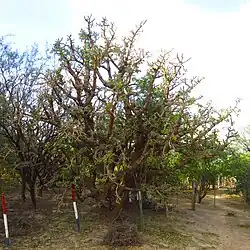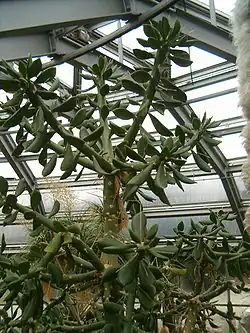Quiabentia verticillata
| Quiabentia verticillata | |
|---|---|

| |
| Mature specimen at Fortín Toledo in Boquerón, Paraguay]] | |
| Scientific classification | |
| Kingdom: | Plantae |
| Clade: | Tracheophytes |
| Clade: | Angiosperms |
| Clade: | Eudicots |
| Order: | Caryophyllales |
| Family: | Cactaceae |
| Genus: | Quiabentia |
| Species: | Q. verticillata
|
| Binomial name | |
| Quiabentia verticillata (Vaupel) Borg
| |
| Synonyms | |
| |
Quiabentia verticillata is a species of cactus found in the neotropical forests of the Gran Chaco region (eastern Bolivia, western Paraguay, northern Argentina, and parts of Brazil).
Description
It is an erect woody succulent plant, growing tree-shaped or shrub-like and reaches heights of 2–15 m (7–49 ft). Its leaves, which are approximately 5 cm (2 in) long and up to 2 cm (1 in) wide, are oval to lanceolate (long, wider in the middle, shaped like a lance tip). Like many cacti, it bears leaves which have become specialized as spines. The spines (up to 7 cm (3 in) long) consist of the stipules of the leaves, and protect the plant from browsing by herbivores. It also bears a second type of leaf that is thickened and fleshy, with a somewhat angular cross-section. These leaves and the stems of the plant enable the storage of water. The bright red flowers are 1.5 centimeters long.[2]
Distribution
Quiabentia verticillata is found in the neotropical forests of the Gran Chaco region (eastern Bolivia, western Paraguay, northern Argentina, and parts of Brazil). It grows in dry sandy soils, typically found at the edge of fields, in wastelands, at the side of roads, and opportunistically in vineyards and orchards when they are not irrigated.
Taxonomy
The first description (as Pereskia verticillata) was made in 1923 by Friedrich Karl Johann Vaupel.[3] The specific epithet "verticillata" comes from Latin, means "whorled" and refers to the shape of the branching of the shoots of the species. Curt Backeberg reassigned the species to genus Quiabentia in 1936. Other nomenclature synonyms are Quiabentia verticillata (Vaupel) Borg (1937) and Grusonia verticillata (Vaupel) G.D. Rowley (2006).[4]
Cultivation and uses
Like most cacti, it is a xerophyte, capable of growing in areas receiving very little precipitation. It has a laterally extensive, shallow root system.
Gallery
-
 Specimen at the Berlin Botanical Garden and Botanical Museum in Germany
Specimen at the Berlin Botanical Garden and Botanical Museum in Germany -
 Detail of fleshy leaves
Detail of fleshy leaves -
 Detail of spines
Detail of spines
References
- ^ "The IUCN Red List of Threatened Species". IUCN Red List of Threatened Species. 2010-09-22. Retrieved 2023-10-15.
- ^ Anderson, Edward F.; Eggli, Urs (2005). Das grosse Kakteen-Lexikon (in German). Stuttgart: Ulmer. p. 557. ISBN 3-8001-4573-1.
- ^ Vaupel, Friedrich (1923). "Zwei Neue Peireskien Bolivien" (PDF). Zeitschrift für Sukkulentenkunde (in German). 1923 (5): 55–56.
- ^ "Au Cactus Francophone". Au Cactus Francophone (in French). Retrieved 2023-10-15.
This article draws from [1], [2], and [3] on the internet, which were accessed in the version of 27 July 2006.
External links
 Media related to Quiabentia verticillata at Wikimedia Commons
Media related to Quiabentia verticillata at Wikimedia Commons Data related to Quiabentia verticillata at Wikispecies
Data related to Quiabentia verticillata at Wikispecies
